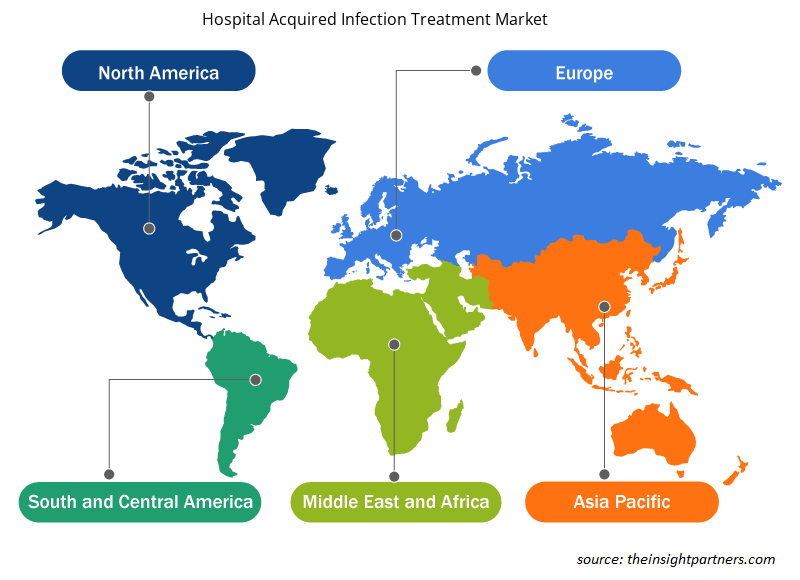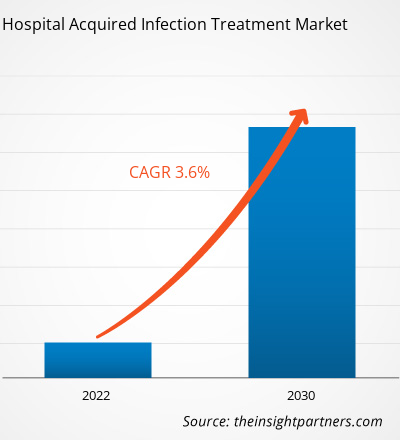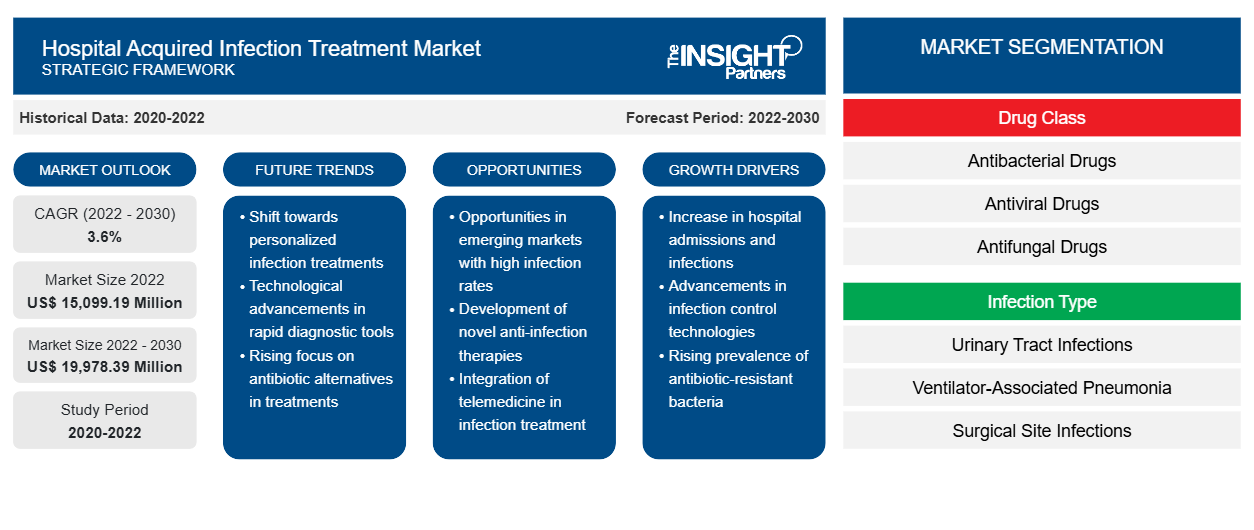[調査レポート]院内感染治療市場は、2022年の150億9,919万米ドルから2030年には199億7,839万米ドルに成長すると予想されており、2022年から2030年にかけて3.6%のCAGRを記録すると予想されています。
市場洞察とアナリストの見解:
院内感染とも呼ばれる院内感染 (HAI) は、病院、長期療養施設、外来診療所など、さまざまな環境で発生する可能性があり、退院後にも発生することがあります。また、HAI には、医療従事者に影響を与える職業感染も含まれる場合があります。院内感染治療市場の成長を牽引する主な要因は、HAI の蔓延率の高さと、患者の安全と質の高いケアへの関心の高まりです。ただし、抗菌薬耐性の脅威が院内感染治療市場の成長を妨げています。
成長の原動力と制約:
中心静脈カテーテル関連血流感染症、カテーテル関連尿路感染症、人工呼吸器関連肺炎は、医療関連感染症(HAI)のいくつかの例として挙げられます。手術部位感染症として知られるこれらの感染症は、手術部位でも発生する可能性があります。2021年に発行された米国疾病予防管理センター(CDC)の報告書「2020年全国および州医療関連感染症進捗報告書」によると、2019年から2020年にかけて、米国では中心静脈カテーテル関連血流感染症、メチシリン耐性黄色ブドウ球菌(MRSA)菌血症、人工呼吸器関連イベントの症例がそれぞれ24%、35%、15%増加しました。
さらに、全米医療安全ネットワーク(NHSN)の2022年1月のレポートによると、尿路感染症(UTI)は医療関連感染症の中で5番目に多いタイプです。UTIは急性期病院の病状の9.5%以上を占めています。カテーテル関連尿路感染症(CAUTI)は、膀胱から尿を排出するために使用される尿道カテーテルによって引き起こされます。CAUTIは、入院中のUTI患者の間で最も頻繁に起こる感染症の1つです。疾病管理予防センター(CDC)によると、感染症の約75%は尿道カテーテルに関連しています。入院中、入院患者の15%から25%は尿道カテーテルを使用する必要があります。尿道カテーテルの長期使用は、CAUTIになる最も大きな危険因子です。CAUTIの合併症は、患者の苦しみ、入院期間の延長、治療費の増加、さらには死亡を伴います。
さらに、CDC によると、UTI は毎年 13,000 人以上の死因となっています。急性の単純性膀胱炎は、約 6 日間の不快感を引き起こし、毎年約 700 万人が受診し、16 億ドルの費用がかかります。その結果、HAI 症例数の増加は医療制度に大きな財政的負担をかけています。CAUTI の有病率の増加と治療薬の需要増加が相まって、市場が成長しています。
しかし、抗菌薬耐性は院内感染治療にとって大きな課題となっており、既存の抗菌薬の有効性が制限され、耐性病原体に効果的に対抗するための新たな治療戦略や抗菌薬の代替品の開発が必要になります。
要件に合わせてレポートをカスタマイズする
このレポートの一部、国レベルの分析、Excelデータパックなど、あらゆるレポートを無料でカスタマイズできます。また、スタートアップや大学向けのお得なオファーや割引もご利用いただけます。
-
このレポートの主要な市場動向を入手してください。この無料サンプルには、市場動向から見積もりや予測に至るまでのデータ分析が含まれます。
レポートのセグメンテーションと範囲:
世界の院内感染治療市場は、薬剤クラス、感染タイプ、流通チャネルに基づいてセグメント化されています。薬剤クラスに基づいて、院内感染治療市場は抗菌薬、 抗ウイルス薬、抗真菌薬、その他に分類されています。感染タイプに基づいて、院内感染治療は、尿路感染症、人工呼吸器関連肺炎、手術部位感染症、血流感染症、その他の院内感染症に分類されています。流通チャネルに基づいて、市場は病院薬局、小売薬局、電子商取引、その他に分類されています。院内感染治療市場は、地域別に、北米(米国、カナダ、メキシコ)、欧州(ドイツ、フランス、イタリア、英国、ロシア、その他の欧州)、アジア太平洋(オーストラリア、中国、日本、インド、韓国、その他のアジア太平洋)、中東およびアフリカ(南アフリカ、サウジアラビア、UAE、その他の中東およびアフリカ)、南米および中米(ブラジル、アルゼンチン、その他の南米および中米)に分類されています。
セグメント分析:
院内感染治療市場は、薬剤クラス別に、抗菌薬、抗ウイルス薬、抗真菌薬、その他に分類されています。抗菌薬セグメントは2022年に最大の市場シェアを占め、2022年から2030年にかけて最高のCAGRを記録すると予想されています。
院内感染治療市場は、感染タイプ別に、尿路感染症、人工呼吸器関連肺炎、手術部位感染症、血流感染症、その他の院内感染に分類されます。尿路感染症セグメントは2022年に最大の市場シェアを占めました。ただし、人工呼吸器関連肺炎セグメントは、2022年から2030年にかけて最高のCAGRを記録すると予想されています。
院内感染治療市場は、流通チャネル別に、病院薬局、小売薬局、電子商取引、その他に分類されています。2022年には、病院薬局セグメントが最大の市場シェアを占め、同じセグメントが2022年から2030年の間に最高のCAGRを記録すると予想されています。
地域分析:
地理に基づいて、世界の院内感染症治療市場は、北米、ヨーロッパ、アジア太平洋、南米および中米、中東およびアフリカの 5 つの主要地域に分類されます。
2022年、北米は世界の院内感染治療市場規模で最大のシェアを占めました。米国ではHAIの有病率が高く、院内感染治療市場の成長を牽引しています。CDCによると、どの日でも、入院患者の約31人に1人が少なくとも1つのHAIに罹患しています。同様に、疾病予防・健康増進局によると、HAIやその他の感染症は敗血症につながる可能性があり、米国では年間約170万人の病気と27万人の死を引き起こしています。このように、米国の人々のHAIの有病率の高さは、院内感染治療市場の成長を促進しています。
業界の発展と将来の機会:
世界の院内感染治療市場で活動する主要企業が行っているさまざまな取り組みを以下に示します。
- 2023年5月、イノビバ・スペシャリティ・セラピューティクスは、米国食品医薬品局(FDA)が、アシネトバクター・バウマニ・カルコアセティカス複合体(アシネトバクター)の感受性分離株によって引き起こされる院内細菌性肺炎および人工呼吸器関連細菌性肺炎(HABP/VABP)の治療薬として、18歳以上の患者を対象に静脈内投与用に包装されたXACDURO(注射用スルバクタム、注射用デュロバクタム)を承認したと発表しました。イノビバ・スペシャリティ・セラピューティクスは、救命救急および感染症における革新的な治療法の提供に注力していると述べました。
- 2023年5月、プネのインド科学教育研究機関(IISER)とラクナウの中央医薬品研究所(CSIR-CDRI)の研究者らは、頻繁に院内感染を引き起こすアシネトバクター・バウマニに対する潜在的な新しい抗生物質を発見したと発表しました。
- 2020年9月、塩野義製薬は、エンテロバクター・クロアカエ複合体、クレブシエラ・ニューモニエ、アシネトバクター・バウマニ複合体、大腸菌、緑膿菌、セラチア・マルセセンスなどの感受性グラム陰性微生物によって引き起こされる院内細菌性肺炎および人工呼吸器関連細菌性肺炎(HABP/VABP)を患う18歳以上の患者の治療薬として、FETROJA(セフィデロコル)の追加新薬申請(sNDA)がFDAにより承認されたと発表しました。
- 2020年6月、メルク社は、米国食品医薬品局(FDA)がRECARBRIO(イミペネム、シラスタチン、リレバクタム)の追加新薬申請(sNDA)を承認したと発表しました。RECARBRIOは、アシネトバクター・カルコアセティカス・バウマニ複合体、クレブシエラ・オキシトカ、クレブシエラ・ニューモニエ、エンテロバクター・クロアカエ、大腸菌、インフルエンザ菌、クレブシエラ・アエロゲネス、緑膿菌、セラチア・マルセセンスなどの感受性グラム陰性微生物によって引き起こされる院内細菌性肺炎および人工呼吸器関連細菌性肺炎(HABP/VABP)を患っている18歳以上の患者の治療薬として承認されました。
院内感染治療市場の地域別分析
予測期間を通じて院内感染治療市場に影響を与える地域的な傾向と要因は、Insight Partners のアナリストによって徹底的に説明されています。このセクションでは、北米、ヨーロッパ、アジア太平洋、中東、アフリカ、南米、中米にわたる院内感染治療市場のセグメントと地理についても説明します。

- 院内感染治療市場の地域別データを入手
院内感染治療市場レポートの範囲
| レポート属性 | 詳細 |
|---|---|
| 2022年の市場規模 | 150億9,919万米ドル |
| 2030年までの市場規模 | 199億7,839万米ドル |
| 世界のCAGR(2022年 - 2030年) | 3.6% |
| 履歴データ | 2020-2022 |
| 予測期間 | 2022-2030 |
| 対象セグメント |
薬物クラス別
|
| 対象地域と国 |
北米
|
| 市場リーダーと主要企業プロフィール |
|
院内感染治療市場のプレーヤー密度:ビジネスダイナミクスへの影響を理解する
院内感染治療市場は、消費者の嗜好の変化、技術の進歩、製品の利点に対する認識の高まりなどの要因により、エンドユーザーの需要が高まり、急速に成長しています。需要が高まるにつれて、企業は提供内容を拡大し、消費者のニーズを満たすために革新し、新たなトレンドを活用し、市場の成長をさらに促進しています。
市場プレーヤー密度とは、特定の市場または業界内で活動している企業または会社の分布を指します。これは、特定の市場スペースに、その市場規模または総市場価値に対してどれだけの競合相手 (市場プレーヤー) が存在するかを示します。
院内感染症治療市場で事業を展開している主要企業は次のとおりです。
- メルク社
- ファイザー株式会社
- アッヴィ株式会社
- パラテック製薬株式会社
- ユージアUS LLC
免責事項:上記の企業は、特定の順序でランク付けされていません。

- 院内感染治療市場のトップキープレーヤーの概要を入手
競争環境と主要企業:
Merck & Co Inc、Pfizer Inc、AbbVie Inc、Paratek Pharmaceuticals Inc、Eugia US LLC、Abbott Laboratories、Cumberland Pharmaceuticals Inc、Innoviva Specialty Therapeutics Inc、Cipla Ltd、およびEli Lilly and Companyは、院内感染治療市場で活動する有力企業です。これらの企業は、新しい技術、既存製品の改良、地理的拡大に注力し、世界中で高まる消費者の需要に対応し、専門ポートフォリオの製品範囲を拡大しています。
- 過去2年間の分析、基準年、CAGRによる予測(7年間)
- PEST分析とSWOT分析
- 市場規模価値/数量 - 世界、地域、国
- 業界と競争環境
- Excel データセット
最新レポート
関連レポート
お客様の声
購入理由
- 情報に基づいた意思決定
- 市場動向の理解
- 競合分析
- 顧客インサイト
- 市場予測
- リスク軽減
- 戦略計画
- 投資の正当性
- 新興市場の特定
- マーケティング戦略の強化
- 業務効率の向上
- 規制動向への対応























 無料サンプルを入手 - 院内感染症治療市場
無料サンプルを入手 - 院内感染症治療市場